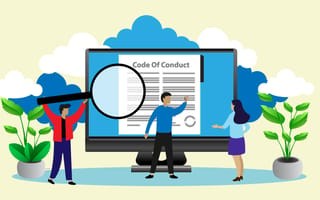
Tech companies need to move past talking and start prioritizing ethics.
Even as technology races forward, the industry continues to not be effectively regulated by governments, which can be made up of officials who don’t understand the tech they’re writing the rules for (and sometimes act unethically themselves), according to Kat Zhou. This lack of proper oversight leaves the door open to missteps, she added: A bad product choice or unethical move could attract negative media attention, legal action or dissuade top talent from working for a company — particularly now as firms race to balance solutions to the COVID-19 pandemic with privacy and other concerns.
“As someone who has the privilege that comes with working in tech, I think we all have a responsibility to really take a good, hard look at what we're putting out there,” said Zhou, a product designer at Spotify who, in her spare time, developed Design Ethically, a framework product teams can use to ensure the features they design keep ethics in mind.
Parts of the Design Ethically framework have been used by IBM — Zhou helped design the company’s ethical framework for AI — as well as in workshops and schools across the country.
To do good in tech is to make sure that you are not harming vulnerable people or creating more of an unequal power distribution in society.”
“To do good in tech is to make sure that you are not harming vulnerable people or creating more of an unequal power distribution in society,” she said.
Zhou believes ethical decision-making needs to permeate not only product teams, but also the board room. An increasing number of tech companies have made this investment, she said. But what these professionals’ days look like is not standardized across the industry.
For firms like San Francisco area Oculus VR, ethicists are in charge of guiding product development. Other companies like the Culver City-based TikTok rely on ethics officials to oversee their internal culture. Still others like the Denver-based Convercent use ethicists to inform their public relations strategy.
“I want to see product teams start thinking about, ‘What are our ethical priorities?’” Zhou said. “Not just thinking about what's good for the bottom line, but what's good, and are we living up to those standards that we want or that others expect from us?”
What Is Design Ethically?
Ethical products offer users autonomy, transparency and safety, Zhou said, naming Apple’s screen time monitor as a model for user transparency. To arrive at these values, she applied two common philosophical schools of thought to Stanford University’s design process, which is the traditional design system that most teams follow.
Using Stanford’s process, product teams develop features by empathizing with their customer, defining their problem, ideating solutions, prototyping products and then testing what they came up with. The ultimate goal, for many firms, is to hit their executive-defined OKRs, Zhou said, which are often designed to generate profit. Zhou wanted to add ethics into the aim too.
To that end, she decided to incorporate the principles of deontological ethics — or, the idea that motives matter when determining the “goodness” of an action — and consequentialism — the idea that the outcome that produces the greatest good for the greatest number validates the means — into the framework.
These schools of thought aligned well with the Stanford process, Zhou said, since the deontological theory focuses on the intent of a product — like when observations about users are made and a problem is identified — and consequentialism focuses on the results, where the team thinks of solutions and eventually ships them out.
How the Framework Differs From the Traditional Process
Zhou launched Design Ethically in 2018, and designed the framework so it could be used by product teams operating in all work styles — from agile to waterfall — and included a series of exercises teams can use to focus in on ethics.
The framework adds four additional steps to the design process.

During the intents phase, the updated framework calls for product teams to evaluate the ethical worthiness of the problem they aim to solve, answering questions like Will the product create a fun experience, or will it exploit people?
Design Ethically also calls for product teams to forecast the effects their solutions could have on society, by thinking of the ethical weak spots or ways their product could be exploited in an unethical way. One trick Zhou said teams can use to forecast their products’ effects is to invert B.J. Fogg’s behavioral model, which states that behavior happens when motivation, ability and a prompt come together in a single moment. Product teams can whiteboard about the different user motivations, and then reflect on the behaviors and consequences that could grow from those aims.
In many cases, no solution is perfect, Zhou said. But that doesn’t mean the problem isn’t worth solving.
“If we lived in a society where we never solved anything because we were always afraid of every potential negative outcome, nothing would ever get solved,” Zhou said. “If you do approach those solutions, you need to watch out for those edge cases. It’s another design problem to solve.”
The Design Ethically framework also adds a step devoted to shipping the product. Once the item is in consumer hands, Design Ethically asks teams to monitor how it is used. An exercise teams can do to monitor their product’s use is to ask themselves a series of questions related to autonomy, transparency and safety, Zhou said. For example: “Is the feature tricking people into paying money?”
“Companies and teams need to do a better job of keeping an eye on what they've put out there,” Zhou said. “Make sure they’re doing check-ins on, ‘Have any new ethically problematic issues cropped up?’ and to circle back and make sure that they go away or we fix that.”



